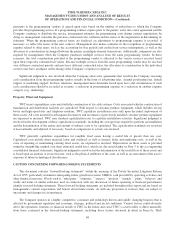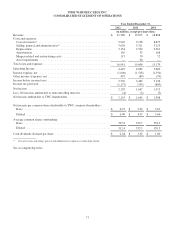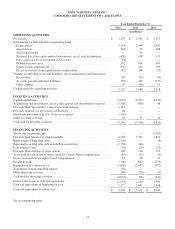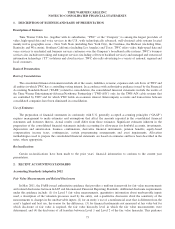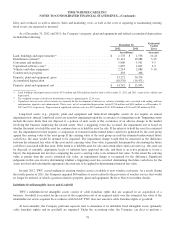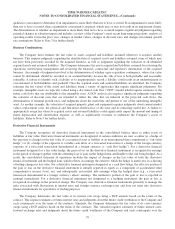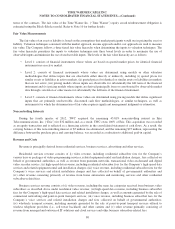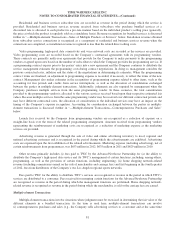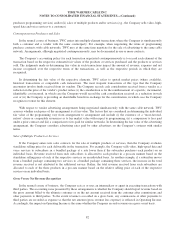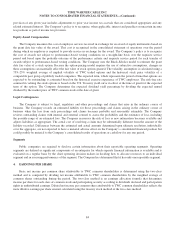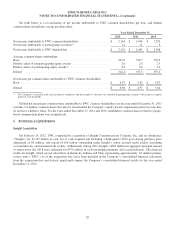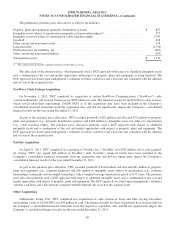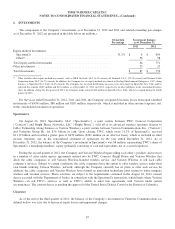Time Warner Cable 2012 Annual Report Download - page 88
Download and view the complete annual report
Please find page 88 of the 2012 Time Warner Cable annual report below. You can navigate through the pages in the report by either clicking on the pages listed below, or by using the keyword search tool below to find specific information within the annual report.
TIME WARNER CABLE INC.
NOTES TO CONSOLIDATED FINANCIAL STATEMENTS—(Continued)
labor and overhead, as well as interest. Sales and marketing costs, as well as the costs of repairing or maintaining existing
fixed assets, are expensed as incurred.
As of December 31, 2012 and 2011, the Company’s property, plant and equipment and related accumulated depreciation
included the following:
December 31, Estimated
Useful
Lives2012 2011
(in millions) (in years)
Land, buildings and improvements(a) ....................................$ 1,778 $ 1,538 10-20
Distribution systems(b) ............................................... 21,141 19,088 3-25
Converters and modems .............................................. 5,806 5,591 3-5
Capitalized software costs(c) ........................................... 1,895 1,607 3-5
Vehicles and other equipment .......................................... 2,214 2,084 3-10
Construction in progress .............................................. 438 468
Property, plant and equipment, gross .................................... 33,272 30,376
Accumulated depreciation ............................................ (18,530) (16,471)
Property, plant and equipment, net ......................................$ 14,742 $ 13,905
(a) Land, buildings and improvements includes $170 million and $158 million related to land as of December 31, 2012 and 2011, respectively, which is not
depreciated.
(b) The weighted-average useful life for distribution systems is approximately 12.34 years.
(c) Capitalized software costs reflect certain costs incurred for the development of internal use software, including costs associated with coding, software
configuration, upgrades and enhancements. These costs, net of accumulated depreciation, totaled $738 million and $658 million as of December 31,
2012 and 2011, respectively. Depreciation of capitalized software costs was $237 million in 2012, $209 million in 2011 and $185 million in 2010.
Long-lived assets (e.g., property, plant and equipment and finite-lived intangible assets) do not require an annual
impairment test; instead, long-lived assets are tested for impairment upon the occurrence of a triggering event. Triggering events
include the more likely than not disposal of a portion of such assets or the occurrence of an adverse change in the market
involving the business employing the related assets. Once a triggering event has occurred, the impairment test is based on
whether the intent is to hold the asset for continued use or to hold the asset for sale. If the intent is to hold the asset for continued
use, the impairment test first requires a comparison of estimated undiscounted future cash flows generated by the asset group
against the carrying value of the asset group. If the carrying value of the asset group exceeds the estimated undiscounted future
cash flows, the asset would be deemed to be impaired. The impairment charge would then be measured as the difference
between the estimated fair value of the asset and its carrying value. Fair value is generally determined by discounting the future
cash flows associated with that asset. If the intent is to hold the asset for sale and certain other criteria are met (e.g., the asset can
be disposed of currently, appropriate levels of authority have approved the sale, and there is an active program to locate a
buyer), the impairment test involves comparing the asset’s carrying value to its estimated fair value. To the extent the carrying
value is greater than the asset’s estimated fair value, an impairment charge is recognized for the difference. Significant
judgments in this area involve determining whether a triggering event has occurred, determining the future cash flows for the
assets involved and selecting the appropriate discount rate to be applied in determining estimated fair value.
In early 2012, TWC ceased making its existing wireless service available to new wireless customers. As a result, during
the fourth quarter of 2011, the Company impaired $60 million of assets related to the provision of wireless service that would
no longer be utilized, of which a portion related to property, plant and equipment. Refer to Note 6 for further details.
Indefinite-lived Intangible Assets and Goodwill
TWC’s indefinite-lived intangible assets consist of cable franchise rights that are acquired in an acquisition of a
business. Goodwill is recorded for the excess of the acquisition cost of an acquired entity over the estimated fair value of the
identifiable net assets acquired. In accordance with GAAP, TWC does not amortize cable franchise rights or goodwill.
At least annually, the Company performs separate tests to determine if its indefinite lived intangible assets (primarily
cable franchise rights) and its goodwill are impaired. Under the accounting rules, the Company can elect to perform a
78


